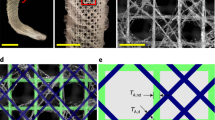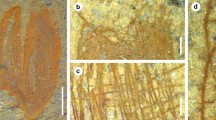Abstract
The biomechanics of body contraction in Porifera is almost unknown, although sponge contraction has been observed already in ancient times. Some members of the genus Tethya represent the most contractile poriferan species. All of them show a highly ordered skeleton layout. Based on three main spicule types, functional units are assembled, termed skeleton superstructures here. Using synchrotron radiation based x-ray microtomography and quantitative image analysis with specially developed particle and structure recognition algorithms allowed us to perform spatial allocation and 3D-morphometric characterizations of single spicules and skeleton superstructures in T. minuta. We found and analyzed three skeleton superstructures in the investigated specimen: (1) 85 megasclere bundles, (2) a megaster sphere, composed by 16,646 oxyasters and (3) a pinacoderm–tylaster layer composed by micrasters. All three skeleton superstructures represent composite materials of siliceous spicules and extracellular matrix. From structure recognition we developed an abstracted mathematical model of the bundles and the sphere. In addition, we analyzed the megaster network interrelation topology and found a baso-apical linear symmetry axis for the megaster density inside the sphere. Based on our results, we propose a hypothetical biomechanical contraction model for T. minuta and T. wilhelma, in which the skeleton superstructures restrain physical stress generated by contraction in the tissue. While skeletal structures within the genus Tethya have been explained using R. Buckminster Fullers principle of tensegrity by other authors, we prefer material science based biomechanical approaches, to understand skeletal superstructures by referring to their composite material properties.







Similar content being viewed by others
References
Abràmoff M (2000–2004) VolumeJ. VolumeJ–volume rendering in Java. http://www.bij.isi.uu.nl/vr.htm 1.71
Aizenberg J, Weaver JC, Thanawala MS, Sundar VC, Morse DE, Fratzl P (2005) Skeleton of Euplectella sp.: structural hierarchy from the nanoscale to the macroscale. Science 309:275–278. http://www.sciencemag.org/cgi/content/abstract/309/5732/275
Bavestrello G, Calcinai B, Ceccati L, Cerrano C, Sarà M (2000) Skeletal development in two species of Tethya (Porifera, Demospongiae). Ital J Zool 67:241–244
Beckmann F, Donath T, Dose T, Lippmann T, Martins RV, Metge J, Schreyer A (2004) Microtomography using synchrotron radiation at DESY: current status and future developments. In: Bonse U (ed.) Developments in X-Ray Tomography IV: SPIE Proceedings 5535, pp 1–10
Bond C (1992) Continuous cell movements rearrange anatomical structures in intact sponges. J Exp Zool 263:284–302
Bond C, Harris AK (1988) Locomotion of sponges and its physical mechanism. J Exp Zool 246:271–284
Boury Esnault N, Rützler K (1997) Thesaurus of sponge morphology. Smithson Contrib Zool 596:1–55
Fishelson L (1981) Observations on the moving colonies of the genus Tethya (Demospongia, Porifera). 1. Behaviour and cytology. Zoomorphology 98:89–99
Fuller RB (1961) Tensegrity. Portfolio 4:112–127
Guth E (1945) Theorie of Filler reinforcement. J Appl Phys 16:20–25
Huesman RH, Gullberg GT, Greenberg WL, Budinger TF (1977) RECLBL Library users manual: Donner algorithms for reconstruction tomography. Lawrence Berkeley Laboratory, University of California
Ingber DE (1998) The architecture of life. Sci Am 278:48–57
Ingber DE (2003a) Tensegrity I. Cell structure and hierarchical systems biology. J Cell Sci 116:1157–1173. http://www.jcs.biologists.org/cgi/content/abstract/116/7/1157
Ingber DE (2003b) Tensegrity II. How structural networks influence cellular information processing networks. J Cell Sci 116:1397–1408. http://www.jcs.biologists.org/cgi/content/abstract/116/8/1397
Ingber DE, Heidemann SR, Lamoureux P, Buxbaum RE (2000) Opposing views on tensegrity as a structural framework for understanding cell mechanics. J Appl Physiol 89:1663–1678. http://www.jap.physiology.org
Koehl MAR (1982) Mechanical design of spicule-reinforced connective tissue: stiffness. J Exp Biol 98:239–268
Koehl MAR (1996) When does morphology matter. Annu Rev Ecol Syst 27:501–542
Marshall W (1885) Coelenterata, porifera, tetractinellidae; Tafel XLVII. In: Leuckart R (ed.) Zoologische Wandttafeln der wirbellosen Thiere. Th. Fischer, Kassel
Minchin E (1900) Sponges. In: Lancester ER (ed) A treatise on zoology. Part II. The porifera and coelentera. Adam & Charles Black, London, pp 1–178
Mullins L (1980) Theories of rubber-like elasticity and the behaviour of fille rubber. Symp Soc Exp Biol 34:273–288
Nickel M (2001) Cell biology and biotechnology of marine invertebrates—sponges (Porifera) as model organisms. Arb Mitteil Biol Inst Uni Stuttgart 32:1–157
Nickel M (2004) Kinetics and rhythm of body contractions in the sponge Tethya wilhelma (Porifera: Demospongiae). J Exp Biol 207:4515–4524
Nickel M, Brümmer F (2003) In vitro sponge fragment culture of Chondrosia reniformis (Nardo, 1847). J Biotechnol 100:147–159
Nickel M, Brümmer F (2004) Body extension types of Tethya wilhelma: cellular organisation and their function in movement. Boll Mus Ist Biol Univ Genova 68:483–489
Nickel M, Donath T, Schweikert M, Beckmann F (2006) Functional Morphology of Tethya species (Porifera): 1. Quantitative 3D-analysis of T. wilhelma by synchrotron radiation based x-ray microtomography. Zoomorphology (in press). DOI 10.1007/s00435-006-0021-1
Palumbi SR (1986) How body plans limit acclimation responses of a demosponge to wave force. Ecology 67:208–214
Rasband WS (1997–2004) ImageJ. National Institutes of Health, Bethesda, Maryland, USA. http://www.rsb.info.nih.gov/ij/ 1.33
Redi CA, Garagna S, Zuccotti M, Capanna EHZ (2002) Visual zoology. The Pavia collection of Leuckart’s zoological wall charts (1877). Ibis, Como
Sarà M (1994) A rearrangement of the family Tethyidae (Porifera Hadromerida) with establishment of new genera and description of two new species. Zool J Linn Soc 110:355–371
Sarà M (1998) A Biogeographic and evolutionary survey of the genus Tethya (Porifera, Demospongiae). In: Watanabe Y, Fusetani N (eds.) Sponge sciences. Multidisciplinary perspectives. Springer, Berlin Heidelberg New York, pp 83–94
Sarà M (2002) Family Tethyidae Gray 1848. In: Hooper JNA, Van Soest RMW (eds.) Systema Porifera: a guide to the classification of sponges, vol 1. Kluwer Academic/Plenum Publishers, New York, pp 245–265
Sarà M, Manara E (1991) Cortical structure and adaptation in the genus Tethya (Porifera, Demospongiae). In: Reitner J, Keupp H (eds) Fossil and recent sponges. Springer, Berlin Heidelberg New York, pp 306–312
Sarà M, Sarà A (2004) A revision of Australian and New Zealand Tethya (Porifera:Demospongiae) with a preliminary analysis of species grouping. Invertebr Syst 18:117–156
Sarà M, Gómez P, Sarà A (2001a) East Pacific Mexican Tethya (Porifera: Demospongiae) with descriptions of five new species. Proceedings of the Biological Society of Washington 114:794–821
Sarà M, Sarà A, Nickel M, Brümmer F (2001b) Three new species of Tethya (Porifera: Demospongiae) from German aquaria. Stuttgarter Beitr Naturk Ser A 631:1–15
Vandenberghe L, Boyd S, Wu S-P (1998) Determinant maximization with linear matrix inequality constraints. SIAM J Matrix Anal Appl 19:499–533
Acknowledgements
We thank Hannes Kirchhauser (Vivarium, State Museum for Natural History, Karlsruhe) for providing sponge material; Ulrich Grün and Thomas Wallmersperger (both Institute for Statics and Dynamics of Aerospace Structures, Stuttgart University) as well as Jörg Hammel (Biological Institute, Stuttgart University) and Birgit Nickel (Stuttgart) for discussion; Hans-Dieter Görtz and Franz Brümmer (both Biological Institute, Stuttgart University) and Frank Allgöwer (Institute for Systems Theory and Automatic Control, Stuttgart University) for providing infrastructure and support. MN received DESY travel grants based on DESY projects I-04-062 and I-03-059.
Author information
Authors and Affiliations
Corresponding author
Electronic supplementary material
Supplementary material 3
Supplementary material 4
Supplementary material 5
Supplementary material 6
Rights and permissions
About this article
Cite this article
Nickel, M., Bullinger, E. & Beckmann, F. Functional morphology of Tethya species (Porifera): 2. Three-dimensional morphometrics on spicules and skeleton superstructures of T. minuta . Zoomorphology 125, 225–239 (2006). https://doi.org/10.1007/s00435-006-0022-0
Received:
Accepted:
Published:
Issue Date:
DOI: https://doi.org/10.1007/s00435-006-0022-0




